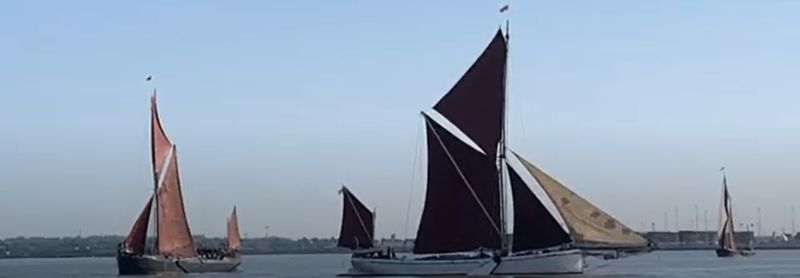 In 1863, Henry Dodd organized a race between Thames River sailing barges. It has become the longest-running, regularly organized, national racing event for traditional sail in the world. In absolute terms, it ranks as the second oldest sailing race behind the America’s Cup.
In 1863, Henry Dodd organized a race between Thames River sailing barges. It has become the longest-running, regularly organized, national racing event for traditional sail in the world. In absolute terms, it ranks as the second oldest sailing race behind the America’s Cup.
Dodd was a wealthy barge owner, who started as a plowboy and made his fortune hauling rubbish. A friend of Charles Dickens, he probably inspired the character Noddy Boffin, the wealthy London “Golden Dustman,” in Dickens’ novel “Our Mutual Friend.”
With pauses only for economic recessions and world wars, the Thames Sailing Barge Match has been sailing ever since. Earlier this month, the 91st Thames Sailing Barge Match was sailed with seven barges in three classes. The competitors ranged in age from two 125 year old barges, the Wyvenhoe and the Niagara, to the relatively new Blue Mermaid built in 2019, which was the first to cross the finish line in this year’s race.
The sailing barges were and remain marvels of maritime efficiency. Shallow draft and nearly flat-bottomed with leeboards, they navigated the shifting mudbanks of the Thames estuary and could safely sit aground waiting for the tide.
They had an average cargo capacity of over 100 tonnes and a typical sail area of 4,200 square feet (390 m2) of canvas in six working sails. Remarkably, they were typically sailed with a crew of only two, or as the saying went, “a man, a boy, and a dog.” They are among the largest sailing vessels in the world sailed with so small a crew.
According to the Society for Sailing Barge Research, 4,860 barges were built for trade from the 18th century to World War I. There were maybe 8,000 in all, including smaller vessels that were unregistered. Only a relative handful have survived.
The Blue Mermaid is particularly notable as it is the first sailing barge built for trade in Britain since 1930. Her design is based on a sailing barge of the same name, one of seven steel-hulled Thames barges built between 1925 and 1930 for F W Horlock. The original Blue Mermaid was sunk by a mine in World War II.
In 2023, the new Blue Mermaid was granted permission by the the Maritime and Coastguard Agency to carry cargoes of up to 110 tonnes, between Lowestoft and Sandwich – and up the Thames, becoming the first UK-registered sailing vessel to be authorized as a commercial cargo carrier since the 1970s.
The Sea-Change Sailing Trust, which owns the Blue Mermaid, provides training and education for young people and vulnerable adults is working with Brightlingsea-based Essex Cement to carry cargo within its authorized range.
Thames, Sailing barge match 2023
Thanks to David Rye for contributing to this post.
